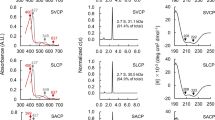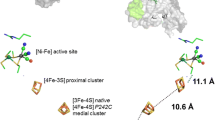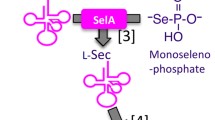Abstract
Study of the adaptation mechanisms of proteins from extremophiles paves the way for the development of new biocatalysts that are resistant to extreme conditions. Here, we studied the structural adaptation of active center channels of octaheme nitrite reductase from the haloalkophilic bacterium Thioalkalivibrio nitratireducens (TvNiR) to high pH. Comparative analysis of the structures of octaheme nitrite reductases adapted to different environmental conditions revealed unique adaptation mechanisms for TvNiR, which play an important role in binding rare protons and substrate and product migration in the active-site channels.
Similar content being viewed by others
Abbreviations
- DSC:
-
differential scanning calorimetry
- СD:
-
circular dichroism
- ONR:
-
octaheme nitrite reductase
- GsNiR:
-
ONR from non-halophilic bacterium Geobacter sulfurreducens
- TvNiR:
-
ONR from haloalkaliphilic bacterium Thioalkalivibrio nitratireducens
References
P. L. Kastritis, N. C. Papandreou, and S. J. Hamodrakas, Int. J. Biol. Macromol. 41 (4), 447 (2007).
S. Fujinami and M. Fujisawa, Environ. Technol. 31 (8–9), 845 (2010).
E. V Pikuta, R. B. Hoover, and J. Tang, Crit. Rev. Microbiol. 33 (3), 183 (2007).
E. Ebrahimie, M. Ebrahimi, N. R. Sarvestani, and M. Ebrahimi, Saline Systems 7 (1), 1 (2011).
D. Y. Sorokin, M. S. Muntyan, A. N. Panteleeva, and G. Muyzer, Int. J. Syst. Evol. Microbiol. 62 (8), 1884 (2012).
M. Moshfegh, A. R. Shahverdi, G. Zarrini, and M. A. Faramarzi, Extremophiles 17 (4), 677 (2013).
A. P. Dubnovitsky, E. G. Kapetaniou, and A. C. Papageorgiou, Protein Sci. 14, 97 (2005).
K. Manikandan, A. Bhardwaj, N. Gupta, et al., Protein Sci. 15 (8), 1951 (2006).
Y. Zhao, Y. Zhang, Y. Cao, J. Qi, et al., PLoS ONE 6 (1), e14608 (2011).
T. Shirai, H. Ishida, J. Noda, et al., J. Mol. Biol. 310 (5), 1079 (2001).
D. Y. Sorokin, Int. J. Syst. Evol. Microbiol. 53 (6), 1779 (2003).
T. Tikhonova, A. Tikhonov, A. Trofimov, et al., FEBS J. 279 (21), 4052 (2012).
A. A. Filimonenkov, R. A. Zvyagilskaya, T. V. Tikhonova, and V. O. Popov, Biochemistry 75 (6), 744 (2010).
K. M. Polyakov, K. M. Boyko, T. V Tikhonova, et al., J. Mol. Biol. 389 (5), 846 (2009).
A. A. Trofimov, K. M. Polyakov, T. V Tikhonova, et al., Acta Crystallogr. D. Biol. Crystallogr. 68 (2), 144 (2012).
M. Biasini, S. Bienert, A. Waterhouse, et al., Nucleic Acids Res. 42 (Web Server issue), W252 (2014).
C. Notredame, D. G. Higgins, and J. Heringa, J. Mol. Biol. 302 (1), 205 (2000).
A. Fiser and A. Sali, Methods Enzymol. 374, 461 (2003).
E. F. Pettersen, T. D. Goddard, C. C. Huang, et al., J. Comput. Chem. 25 (13), 1605 (2004).
R. Salomon-Ferrer, A. W. Götz, D. Poole, et al., J. Chem. Theory Comput. 9 (9), 3878 (2013).
M. L. Hekkelman, T. A. H. Te Beek, S. R. Pettifer, et al., Nucleic Acids Res. 38 (Web Server issue), W719 (2010).
V. Sadovnichy, A. Tikhonravov, V. Voevodin, and V. Opanasenko, in Contemporary High Performance Computing: From Petascale toward Exascale (CRC Press, Boca Raton, FL, 2013), pp. 283–307.
T. N. Petersen, S. Brunak, G. von Heijne, and H. Nielsen, Nat. Methods 8 (10), 785 (2011).
K. G. Tina, R. Bhadra, and N. Srinivasan, Nucleic Acids Res. 35 (Web Server issue), 473 (2007).
O. S. Smart, J. G. Neduvelil, X. Wang, and B. A. Wallace, J. Mol. Graph. 14 (6), 354 (1996).
G. Zhang, L. Zhang, D. Yang, et al., Acta Crystallogr. B. Struct. Sci. Cryst. Eng. Mater. 72 (1), 20 (2016).
O. Einsle, A. Messerschmidt, R. Huber, et al., J. Am. Chem. Soc. 124 (39), 11737 (2002).
Author information
Authors and Affiliations
Corresponding author
Additional information
The article was translated by the authors.
Original Russian Text © A.V. Popinako, T.V. Tikhonova, M.Yu. Antonov, K.V. Shaitan, V.O. Popov, 2017, published in Biofizika, 2017, Vol. 62, No. 2, pp. 284–289.
Rights and permissions
About this article
Cite this article
Popinako, A.V., Tikhonova, T.V., Antonov, M.Y. et al. Structural adaptation of active center channels of octaheme nitrite reductases from the haloalkaliphilic bacteria Thioalkalivibrio nitratireducens to a proton deficit. BIOPHYSICS 62, 214–219 (2017). https://doi.org/10.1134/S0006350917020191
Received:
Published:
Issue Date:
DOI: https://doi.org/10.1134/S0006350917020191




